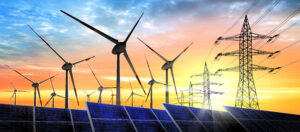Roadblocks on the Path to Greening the Grid
One might be surprised to learn the U.S. electrical grid has existed for over a century. Though it’s an engineering feat, the grid’s age becomes a significant concern when sustainability enters the conversation.
Modernizing this expansive network serves a purpose far beyond mere convenience — it is vital in lowering carbon emissions and fighting climate change. What obstacles are standing in the way of a greener electrical grid?
-
Outdated Infrastructure
The U.S. electrical grid is a relic of a bygone era. It served the needs of a much different energy landscape. Its structure cannot handle the unique demands of renewable energy sources like solar and wind.
When transmitting energy, the existing grid could be more efficient. Much power is lost as it travels through miles of outdated wires and transformers. News agency Reuters reported an average of 9,656 outages each year from 2015 to 2020. This number is more than twice the average of the preceding six-year period.
-
Regulatory Hurdles
Policy and regulation often act as speed bumps on the road to a more sustainable electrical grid. There is a tug-of-war between state and federal regulations, each with rules and priorities. This clash can lead to delays and even stop sustainable projects.
For instance, federal permitting guidelines have sometimes acted as barriers, slowing the development of clean grid projects. The disconnect between varying levels of government complicates the already challenging task of making the grid more eco-friendly.
The Energy Department recently finalized an agreement that guarantees the efficient resolution of environmental review processes within two years. This arrangement is a step forward as the Biden administration and Congress consider utilizing federal authority to sign off transmission line projects.
-
High Initial Costs
Implementing renewable energy sources is a complex endeavor. The initial costs for solar panels and wind turbines can be substantial. These high upfront expenses often discourage potential investors, denting the transition to a more sustainable grid.
As a result, numerous projects aiming for a cleaner grid have either failed to take off or experienced significant delays due to a lack of funding. This financial barrier is a critical obstacle that needs addressing to move toward sustainability.
-
Energy Storage
Storing energy from renewable sources poses another considerable challenge. While renewable energy like solar and wind is abundant, it is also intermittent, meaning it only sometimes produces power.
Current storage solutions, such as batteries and liquid transformers, are outside the task of efficiently storing this fluctuating energy supply for later use. However, people use them to convert high-voltage electricity into a lower current they can use.
The inefficiency in existing storage technologies highlights the dire need for innovation. Advances in energy storage will play a pivotal role in making the grid more resilient and sustainable.
-
Public Perception
A significant part of the public is still apprehensive about making the electrical grid more sustainable. Misinformation, often propagated through social media, is pivotal in this resistance.
The spread of incorrect data or the simple lack of accurate information hampers the speed and effectiveness of implementing sustainable changes to the grid, making public education and awareness more crucial than ever.
-
Interconnected Systems
The electrical grid is not an isolated entity — it intricately connects various sectors, such as transportation and manufacturing. Changes to the grid inevitably ripple across these areas, requiring a coordinated effort for effective implementation.
For example, shifting to renewable energy could impact the rise of electric vehicles or how factories operate. The complexity of these interconnections adds another layer of difficulty in modernizing the grid. Coordinating changes across these sectors is essential but challenging, making grid modernization a multidimensional puzzle.
-
Project Scalability
Scaling up smaller renewable energy projects to meet national demands presents a unique challenge. Often, these projects excel on a local or regional scale but hit roadblocks when attempting to expand.
Technological constraints and resource limitations serve as common challenges for scalability. Therefore, developing scalable solutions becomes crucial for the broader adoption of renewable energy in the U.S. electricity grid.
-
Natural Disasters
Extreme weather events, including wildfires and hurricanes, are emerging as significant threats to the electrical grid. These occurrences can disrupt conventional energy sources like coal and natural gas and renewable ones like solar and wind.
The need for a more resilient grid to withstand these challenges becomes increasingly urgent in light of such vulnerabilities. Building resilience into the grid is no longer optional — ensuring a stable and sustainable energy future is necessary.
-
Workforce Training
The transition to renewable energy has a human cost, particularly for workers in traditional energy sectors like coal and oil. As these industries decline, workers face the risk of job displacement.
There is a pressing need for retraining programs to prepare these individuals for roles in the emerging clean energy sectors. However, the need for a skilled workforce in these new fields can be a significant hurdle, slowing the pace of sustainable changes to the electrical grid.
Next Steps for a Sustainable Future
Transforming the U.S. electrical grid into a sustainable system faces multiple challenges. From outdated infrastructure and regulatory hurdles to financial constraints and technological limitations, the obstacles are many. Add to that the threats from extreme weather events and workforce challenges, and the complexity deepens.
However, overcoming these hurdles is not just important — it is urgent. Every roadblock the people clear takes the country a step closer to a more sustainable, resilient, and efficient electrical grid.
